Table of contents
counselor
workshop
MotoGP technology: valve trains
MotoGP technology: valve trains
Sex offender
Stoner? Traction control? Tire technology? Happiness? It is difficult to say what ultimately decided the 2007 MotoGP World Championship. What is certain, however, is that valve trains played an important role: as a technical tip on the scales and a subject of lively discussions. MOTORRAD analyzes, explains the different systems and dares to make forecasts.
Jorg Schuller
January 17, 2008
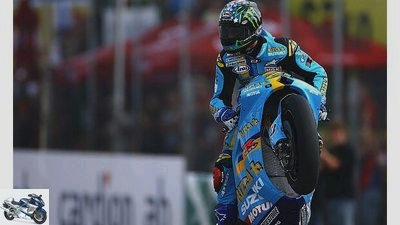
Rizla Suzuki
Air number? Suzuki pilots like John Hopkins achieved not only respectable successes in 2007 thanks to pneumatically assisted valve train.
There had been plenty of predictions and speculations before the 2007 MotoGP season – and then everything turned out very differently. Neither secret favorite Dani Pedrosa nor Valentino Rossi, who was flirting with Formula 1 plans, dominated the world championship. Many had bet that the giants Honda and Yamaha would set the bar for the first year of the 800 cc formula with their RC 212 V and YZR-M1 racers. The superior performance of Casey Stoner and his lightning-fast GP7-Ducati D16 at the very first race in Qatar, where he literally distanced Rossi by three seconds and Pedrosa by eight seconds, not only shook the fans’ worldview. What went wrong?
At the beginning of the age of 21-liter consumption limits, Honda had tailored a tiny motorcycle around Pedrosa racing flea – not only world champion Nicky Hayden had to struggle with it. When it comes to the drive, Honda relied on the tried and tested: the 990 RC 211 V engines had also won with astonishingly conventional technology in terms of consumption limits, with a slightly extreme stroke-to-bore ratio (allegedly around 0.57 compared to an extreme 0.47 the Ducati) – and with valve trains via bucket tappets with steel closing springs. Supposedly logically, Honda cut a cylinder of the V5, left the technology, including the 16,500 rpm speed limit – and made a big miscalculation.
Yamaha got a similar bogus, their shrink-M1 with at least a higher speed reserve, but with a comparatively conservative valve train – and without Rossi’s top class would have seldom shone as usual. Especially since not only Stoner’s Ducati howled up and away, but also the Kawasaki ZX-RR, which in winter was still mocked as immature, and especially the Suzuki GSR-V, suddenly played at eye level. What had the two Japan giants missed? In the big puzzle of a MotoGP motorcycle, in addition to the dominating electronics, the valve trains in particular differentiated their bikes from their unexpectedly strong opponents. The strength of Suzuki and Kawasaki was based on the potential of pneumatic closing springs, that of Ducati on the desmodromic.
So Suzuki and Kawasaki had already prepared their success in 2006, their motorcycles already designed for the requirements of the new class – apart from the engine, the GSV-R and the ZX-RR are extremely similar to their 990 predecessors. Both let their engines turn around 18,000 rpm in 2007, Ducati with the Desmodromic even allowed 19,000 rpm. Yamaha and Honda hadn’t expected that.
The 800s gave the engines a tricky task: to produce outstandingly usable power, but still get by on 21 liters of gasoline. Now, in principle, the performance determination always goes the same way: Burn a mixture of air and fuel in the combustion chamber, gain the highest possible combustion pressure and implement it as effectively as possible. If this often succeeds – i.e. at high speeds – the engine develops a lot of power.
The gigantic performance of the Moto GP engines is primarily based on the efficiency of this gas exchange. They should not be understood as something that is closed with the respective cycle, but rather as a regular flow of inlet and exhaust gases, in which pressure waves create overpressure bulges. This is exactly what the designers want to see in the combustion chamber, as perfectly as possible between the opening and closing of the valves. The key to this is provided by the valve control.
Last year, the four-cylinder Honda had a maximum of 550 ignitions per second, the 600 Kawasaki, Suzuki and later Yamaha. The Ducati V4 fired 85 times more often per second than the Honda. That explains the additional power of the Duc of at least 20 hp. But how did the GP7 and the two little Japanese guys get by with the 21 liters of fuel? Because their apparently outsider concepts allow less drag and lower consumption in some speed ranges, and also tolerate higher speeds. How this works in detail is explained by the boxes for the respective systems: properties that played the famous tip of the balance of the so hard-fought success.
The valve controls of all manufacturers are similar in many basic components and data. All MotoGP valves open around 13 millimeters on the exhaust side and around 15 millimeters on the intake side – enormous compared to standard engines. In all 800s there should be two intake valves per cylinder with a disc diameter of around 33 to 36 millimeters and two exhaust counterparts each with 26 to 29 millimeters – four-valve technology with narrow valve angles of 18 degrees. All four valves in each combustion chamber are made of titanium alloys, which are adapted to the immense demands of their hectic GP life through the partner elements aluminum and vanadium – pure titanium would not last long. In the groove at the transition between the valve head and stem, the exhaust valves can withstand temperatures of over 700 degrees. Valve guides and seat rings made of copper alloys, reinforced by beryllium or aluminum oxide, which is frowned upon because of its toxicity, transport the destructive heat away from the critical areas of the valves through good thermal conductivity, and are also stable enough for the enormous loads, especially on the pneumatic valve drive, which does not turn its valve disc like other concepts.
The tremendous engine speeds require safe implementation, as do the extreme speed fluctuations to which the engines are exposed, for example when shifting down quickly. In principle, camshafts and crankshafts behave like the torsion bar suspension of the blessed VW Beetle: They twist and unwind, swinging, albeit minimally, around their longitudinal axis, thank God. Timing chains, which drive the camshafts on almost every production motorcycle, could catch nasty resonances as a result: chain slapping. Very bad when the valves hurry away from the approaching pistons at tiny tenths of a millimeter intervals during the compression stroke in order to avoid fatal contact that would end in shattered components. Basically, all MotoGP valve trains halve the speed of the crankshaft through straight-toothed gears, which are often arranged in an interesting manner for a compact engine. This allows for small cam wheels, which reduces the inertia of the valve train as well as the size of the engine.
Honda and Yamaha have mastered all of this – just too conservatively. The rescue attempts in the middle of the season resulted in engine damage and dissatisfaction, which is why Yamaha is said to have experimented with four different head configurations. In 2008, probably just like Honda, to compete with pneumo springs, even if Yamaha’s chief developer Masao Furusawa still denied this in Valencia. However, MOTORRAD believes that it is unlikely that we will see a Honda with desmodromics, as has been assumed here and there. It is much more conceivable that variable valve trains will be used as early as 2008 – both Honda and Yamaha are thinking about dynamic valve timing changes using rotatable camshafts or adjustable elevation curves through cam deactivation or stroke changes.
The question that remains is whether MotoGP technology is moving further and further away from the production motorcycle due to its valve controls. No, because Ducati has a tamed production D16 on the road. Yes, because pneumo springs operate in speed ranges that are simply unnecessary for series-produced motorcycles – and cause metal salad in the engine if the pneumatic system loses too much pressure. A second no, however, because in MotoGP sport, maximum performance is called for under a consumption limit. The manufacturers gain experience that will ensure what many of us want in the coming years, even under strict emissions legislation: strong, sporty motorcycles.
Pneumatics
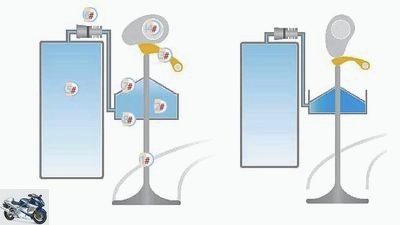
BILLION
Pneumatic valve springs offer scope for development.
A pneumatically assisted valve control – on the right the cylinder head of the KTM MotoGP engine – does not open the valves (1) pneumatically, but closes them with gas springs (2) instead of conventional metal coil springs. Similar to KTM, Kawasaki, Suzuki and Yamaha allegedly switched rocker arms (3) between camshaft (4) and valve (1). Compared to bucket tappets, this saves around 25 percent of the oscillating mass, and allows geometrically more violent valve accelerations (see diagram on page 138), which enables very efficient valve lift curves with the masses saved on the valve springs. Pneumatic springs allow the engine to run downright easier, thereby saving fuel and power loss. They also allow higher speeds because, thanks to their lower oscillating masses, the less inert valve assemblies reliably follow the cam contour even when closing very quickly, whereby the progressive rate curve of the gas spring also helps. If the speed level continues to rise, this safety can be increased simply by increasing the pressure.
All manufacturers feed the gas springs from a storage container (5) that contains nitrogen at a pressure of 150 to 250 bar. The pressure reducing valve (6) is used to set an initial pressure of 9 to 14 bar, which increases to a maximum of 30 bar during compression. Unavoidable leaks between piston (7) and cylinder (8) – in principle built like an air pump – are compensated for by the reservoir. If there is a loss of pressure, the valves fall helplessly into the combustion chamber, and motor salad is inevitable. Another problem: conventional springs rotate the valves, which avoids load and temperature peaks between the plate and seat ring and guarantees permanent tightness. Air springs do not do this, which requires very precise manufacturing and very resistant, exotic and expensive seat materials.
Desmodromic
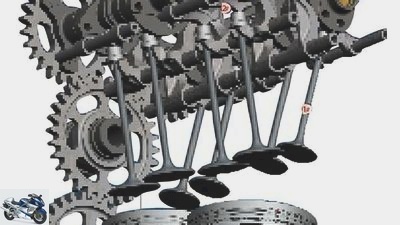
BILLION
The desmodromic system works with less loss at medium speeds, can turn higher and move the valves more radically. That saves fuel and delivers performance.
As with all of its production motorcycles, Ducati relies on desmodromic valve control in the D16 engine – the know-how advantage over possible Japanese competition will always be over 50 years since the first steps of the legendary designer Fabio Taglioni. Ducati is looking confidently into the year 2008. The GP8 is said to be turning over 20,000 rpm on the test bench, and in the past season, Casey Stoner was always able to achieve 1,000 more revolutions than all its competitors at 19,000 rpm. As the?
The desmodromic forces the valves (1) to open and close mechanically. To do this, a rocker arm (2) translates the contour of the opening cam (3) onto the valve (1), while an L-shaped rocker arm (4) closes the valve following a closer cam (5). In contrast to spring-closing systems, inertia-related movements away from the intended paths are impossible; lifting of the valve from the cam during the closing process is reliably prevented. Thanks to this stability of movement, the Desmo drive can cope with higher speeds and also allows more violent valve accelerations than conventional drives with closing springs, i.e. more favorable control times and valve lift curves (see diagram on page 138): The Ducati can open and close its valves more cheaply for the gas exchange and at the same time the range of the Valve overlap – exhaust valve still open, inlet valve already open – keep it smaller. This results in better filling and thus more effective combustion with lower flushing losses, i.e. lower fuel consumption.
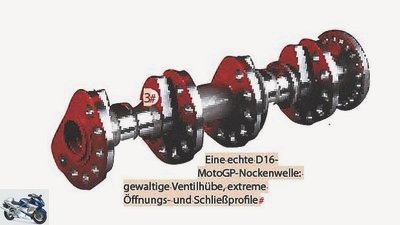
BILLION
MotoGP camshaft.
The oscillating mass fraction per valve, in view of two actuating levers, should hardly be smaller than with spring systems despite the fact that the closing spring has been saved, which is why the desmodromic system probably does not save any drag in the upper speed range, but works against less resistance in the middle. In this way, it can achieve the same performance with less fuel.
Less power loss in the engine then means either better acceleration of the motorcycle or less consumption with comparable performance. The desmodromic system with its free-hanging valves does not even fight against the valve rotation problem of the pneumatic closing springs. There is, however, one negative aspect: The load, especially on the closer levers, is enormous, and their wear and tear is correspondingly high.
Valve springs
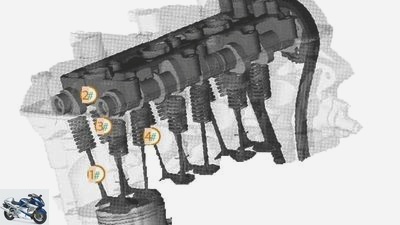
BILLION
Valve springs.
Honda and Yamaha operated their valves (1) in the first year of the 800 cc regulations like most production engines: opening by camshaft (2) and bucket tappets (3), closing by metal valve coil springs (4). In doing so, they resorted to decades of experience in the high-performance area (in the picture a series head), but accepted disadvantages related to the concept. Valve springs only work reliably up to around 18,000 rpm. And for that you have to pull out all the stops, firstly to keep the oscillating masses low, secondly to provide enough closing spring force to close the valve cleanly, thirdly to minimize resonance vibrations of the closing spring.
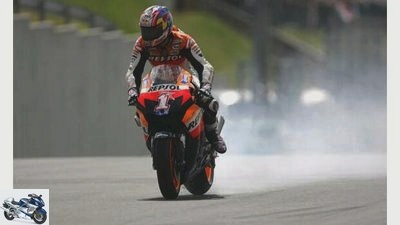
2snap
At the limit: Hayden struggled with the exhausted valve train of his Honda.
Everything together increases the internal friction and thus the drag power of the valve train – to the limit where today’s materials can no longer go any further. The bucket tappet, in particular, increases the oscillating masses by up to 25 percent compared to conventional rocker arm drives. To do this, he provides assistance in guiding the valve, which he spares from transverse forces. The spring also has weight – and contributes to the inertia of the system: Even 40 to 50 oscillating grams oppose their return movement within a few thousandths of a second. The spring rate must be selected to be hard, especially with sharp control times, so that the spring can hold the valve on the closing contour of the cam at high speeds.
This ability has limits, which on the one hand limits the possible opening curves of the valves and on the other hand requires excessive overlaps between the still open exhaust and the already open intake if one does not want to do without good combustion chamber filling. The result: flushing losses, i.e. higher fuel consumption. This is further increased by the high valve spring rate, especially in the medium engine speed range, where it provides maximum opening resistance despite lower requirements. But all in dimensions that would work wonderfully on production motorcycles.
System comparison
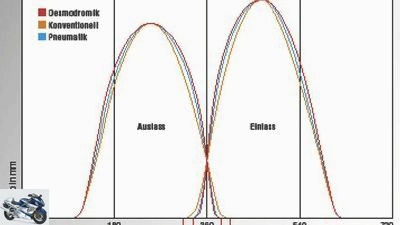
BILLION
System comparison.
The valve lift curves show how the opening areas of the exhaust valves (left) and intake valves (right) behave during two revolutions of the crankshaft. An ideal course would show two adjacent rectangles – unfortunately the physics prevents sudden opening and closing of the valves.
The orange curve symbolizes a conventional valve train (e.g. Honda). The enclosed areas are the smallest, so they give the gas exchange the smallest chance. In addition, the valve overlap is large. This costs fuel due to flushing losses. The pneumatically assisted rocker arm drive à la Suzuki (blue) can open and close harder due to lower oscillating masses, which increases the surface area, improves the gas exchange, and optimizes the overlap and thus the consumption. The desmodromic of the Ducati (red) goes one step further as a result of compulsive movement control.
Related articles
-
Technology development in valve actuation
factstudio.de 23 pictures Katrin Sdun 1/23 Before valve actuation via rocker arms prevailed, numerous other designs determined the state of the art. Ralf…
-
2snap Sports & scene Motorsport Report: MotoGP technology The technology in the MotoGP class Stefan Bradl on the bikes in the premier class Content of…
-
motorcycles Enduro Technology Honda CRF 450 R Technology Honda CRF 450 R For the sake of simplicity Why complicated when it can be made easy? This is…
-
Ducati 10 pictures Ducati 1/10 …compact, rotatable hydraulic units on each camshaft, variable timing. The pulse generators for the position of the…
-
Technology of the new Ducati engine
counselor technology & future Technology of the new Ducati engine Technology of the new Ducati engine Now it’s getting tight 13 years ago, the four-valve…
-
This is how the new super sports technology works
Suzuki 20th pictures Suzuki 1/20 The Suzuki GSX-R combines high tech with clever engineering. Suzuki 2/20 This centrifugal force mimic adjusts the timing…
-
Technology: BMW S 1000 RR engine in detail
BMW 13th pictures Artist 1/13 The on-board tool kit of the BMW almost ties in with old traditions. With the help of the nine-part set you can strip the…
-
Technology: injection electronics
K counselor technology & future Technology: injection electronics Technology: injection electronics What’s humming there?? Content of When five-year-olds…
-
Yamaha counselor technology & future Valve control gas exchange PS technology series part 2 Valve control and gas exchange Content of Almost exactly four…
-
Technology of the 2002 model year
motorcycles Technology of the 2002 model year Technology of the 2002 model year Undercover In the 2002 season it is the inner values that count, and…